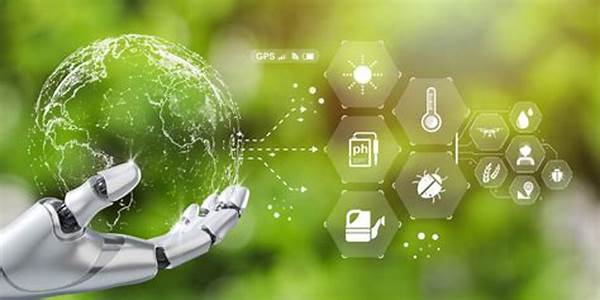Certainly! Let’s dive into creating a comprehensive exploration of the role of AI in environmental protection across several different formats and writing styles.
Read More : Best Insights From Global Ai Reports In 2025
—
In an age where technology is evolving faster than ever, the intersection of artificial intelligence (AI) and environmental protection is creating groundbreaking pathways toward a sustainable future. Imagine a world where the daunting challenge of environmental conservation is met with intelligent systems that predict disasters, reduce waste, optimize energy usage, and more. The potential of AI in this arena is limitless. But before exploring the technicalities, let’s comprehend why AI’s role in environmental protection is pivotal. Today, as you stand with one foot in the future and one in the rapidly depleting natural resources of our planet, it’s crucial to see how AI could be the superhero we didn’t know we needed. This isn’t just an innovation—it’s a revolution. Welcome to an exclusive experience that blends high-tech with high-impact for the Earth’s breath of life.
Imagine your typical day. How many disposable cups do you throw away? How much electricity does your household consume? And how many miles do you drive without thinking? Now imagine AI managing all these aspects for you with optimal efficiency. Sounds futuristic? That future is now. AI doesn’t just digitize systems; it teaches them to think. What if machines could not only analyze but predict and implement strategies to protect our environment? This invitation into the future seeks your commitment, your desire to act. It’s not merely a service or a commodity; it’s a collective endeavour with a call to action. AI wants you on its team! Join this modern-day revolution that’s not just about today’s growth but tomorrow’s survival.
Transforming Environmental Conservation with AI
The role of AI in environmental protection is becoming increasingly significant. AI-powered solutions can analyze vast amounts of environmental data in real time. This allows for more efficient monitoring of deforestation, carbon emissions, and water quality, among other crucial environmental concerns. As governments and organizations seek effective ways to tackle climate change, AI provides a technological backbone to these efforts, optimizing resource usage and minimizing human error. Its transformative power lies in its ability to offer quick, reliable insights that guide policy-making and corporate responsibility.
By integrating AI into environmental strategies, we witness a synergy that is both effective and desirable. Organizations benefit from streamlined operations with reduced resource waste, while environmentalists gain an ally that enhances fieldwork accuracy. This partnership leads to desirable outcomes, such as reduced operational costs and improved sustainability. If you’re part of an organization seeking innovative solutions, consider exploring how AI can redefine your environmental approach.
—
Structuring the Future with AI in Environmental Protection
Artificial intelligence, often perceived as the domain of Silicon Valley tech giants, is carving out a place in environmental conservation, revolutionizing how we approach this critical issue. What exactly is the role of AI in environmental protection, and how can it help resolve the challenges facing our planet? Delve deeper into this fascinating narrative to witness not only the stats but also the exciting, effective transformations AI brings to environmental stewardship.
The stories are numerous. From Google AI predicting deforestation hot spots, saving thousands of trees, to autonomous drones identifying marine pollution, AI is not a backseat player in this theatre. It’s the spotlight, the director, and sometimes even the stage—creating new narratives where conservation is not just possible but practical. This isn’t just about tech-savvy solutions; it’s about creating an eco-friendlier world through data-driven action.
Exploring Applications
The role of AI in environmental protection extends to various fields, each with its unique challenges and solutions. AI assists in predicting climate patterns, improving waste management systems, and even in wildlife conservation efforts. For instance, AI algorithms have been developed to analyze satellite images to monitor and manage deforestation more efficiently. This application is critical given the increasing rates of deforestation.
What does this mean for average consumers? It translates to improved energy consumption patterns, reduced carbon footprints, and involvement in smart grid technologies that ensure efficient energy distribution. Who wouldn’t want lower utility bills coupled with a feel-good factor of contributing towards a sustainable community?
Driving Change with Data
AI is not just analyzing data—it’s revolutionizing how data is used. Real-time analytics allow for proactive environmental strategies, from predicting natural disasters to optimizing agriculture with precision farming techniques. Imagine the possibilities when your farm not only grows produce but is also a sentinel against drought through intelligent irrigation systems informed by AI data analysis.
Investing in AI solutions for environmental protection means more than just staying ahead of the tech curve. It embodies a commitment to sustainable progress and a cleaner future. Engage with AI to stand not only as market leaders but as envoys of change, championing the cause of environmental stewardship through innovation.
—
Summarizing the Role of AI in Environmental Protection
Unveiling the Potential of AI in Environmental Solutions
In a world where digital treasures rule the economy, the untapped potential of AI in environmental protection is like discovering a hidden treasure chest. With every technological advancement comes the promise of a cleaner, greener planet. The wave of AI-driven solutions represents more than a technological trend; it symbolizes hope. Hope for a better tomorrow, one that’s less polluting and more inclusive. In this digital age, where every click is a piece of history, AI stands out as a historian, a sentinel, and a warrior, working tirelessly to conserve and protect our environment.
What does the average consumer stand to gain from this influx of AI in environmental services? Improved quality of life, cost savings, and the noble knowledge of contributing to something greater than oneself—the preservation of our shared home. It’s not just companies or governments that benefit from AI, but your everyday individual, becoming actively involved in monumental changes, aided by AI’s capable hands. From climate scientists to farmers and urban planners, everyone is invited to this burgeoning field.
Revolutionary Applications
AI’s role extends beyond simple diagnostic tools. It’s about innovation, reimagining what’s possible. In industries like agriculture, AI aids in weather prediction to determine optimal planting times. In urban environments, it manages traffic to reduce emissions. These advancements are reshaping the economic landscape and reimagining urban spaces to be smarter and more sustainable. Crucially, these changes are accompanied by tangible results. It’s not just words and codes; it’s livelihoods and ecosystems transformed. You are either part of this revolution or watching it from the sidelines. A smart choice invites you to be part of this legacy.
Sprouting New Life with AI
With an ever-growing population and significant environmental burdens, here’s your chance to cultivate a partnership with artificial intelligence, leading to sustainability. How does this partnership manifest? Through automated systems detecting water leaks and drones fertilizing crops more efficiently. AI isn’t just observing; it’s actively participating. This blend of technology and eco-conscious strategy isn’t science fiction; it’s this Saturday or the next budget report. Embrace the versatile AI solutions, and be a frontrunner in protecting our green globe.
—
Decoding AI’s Environmental Impact
The Dynamics of AI in Safeguarding the Environment
Exploring the puzzle that is AI and its enormous potential, many wonder how this digital wizardry finds itself fighting villains like climate change and pollution. Yet, here we are, witnessing AI as a valiant warrior in our environmental saga. It’s clear: the role of AI in environmental protection is more than a trend; it’s a transformative cornerstone of our survival strategy. When you merge advanced machine learning techniques with environmental science, magic happens.
Welcome to the crossroads of technology and ecology, where AI isn’t just a supporting act but a main player in environmental advocacy. AI-powered models accurately predict air quality fluctuations, thus safeguarding public health. Your supermarket tomatoes might have originated from AI-guided farming techniques, reducing waste—a testament to the tireless AI inventions making your life better every day.
Shaping a Sustainable Tomorrow
AI technologies are already showing how successful results from insights and prompt actions manifest. For instance, AI is aiding policymakers in drafting comprehensive environmental legislation based on accurate data. With advanced monitoring tools, even the subtlest environmental changes do not go unnoticed, steering timely interventions. These advancements signal a roadmap where AI is a co-captain navigating us through a sustainable future.
The Ripple Effect of AI Innovations
The brighter side of AI’s role is the cascading effect on economies, societies, and cultures world over. Introducing AI into environmental protection doesn’t merely solve immediate problems but creates opportunities for a thorough re-evaluation of how industries interact with nature. We witness a chain reaction of progress, innovation, and sustainability across sectors, and it begins with leveraging AI effectively.
As a cornerstone of modern environmental policy and corporate responsibility, embracing AI means embracing a brighter, cleaner future. Engage with this unique narrative today, and become a vanguard for positive change.
—
By utilizing AI in these innovative ways, society stands poised at the threshold of a better world, one where human activities align harmoniously with the planet’s natural processes. Embrace this fusion of technology and ecology and play your part in the ongoing narrative of environmental protection.


